#web to print technology
Explore tagged Tumblr posts
Link

How to Start a Successful Web to Print Business with 4Over?
Want to know how you can start your online printing business? Click here to know the step by step process to kick off your web to print business.
Click the link o know more: https://addwebsolution.com/blog/things-you-should-be-aware-start-your-web-print-business-4over
For More details visit our website: www.addwebsolution.com or call us on India: +91-079-29705640 UK: +44-141-628-2177 or Email us on [email protected]
#Printing business#Printing Industry#Printing#Small Business#4Over#web to print#Web to print business#web to print software#web to print solutions#web to print technology#web to print online
0 notes
Text
UV-based Printing Ink Product to Retain its Dominance, Contributing to Digital Printing Packaging Market Growth, Says MarketsandMarkets™
UV-based Printing Ink Product to Retain its Dominance, Contributing to Digital Printing Packaging Market Growth, Says MarketsandMarkets™
Digital Printing Packaging Market According to a research report “Digital Printing Packaging Market by Printing Inks (Solvent-based, UV-based, Aqueous), Printing Technology, Format, Packaging Type (Corrugated, Folding cartons, Flexible Packaging, Labels), End-use Industry and Region – Global Forecast to 2027″ published by MarketsandMarkets, the global digital printing packaging market size is…

View On WordPress
#Demand for Digital Printing Packaging#digital package printing#digital printing corrugated packaging#digital printing flexible packaging#Digital Printing Packaging#Digital Printing Packaging Industry#Digital Printing Packaging Market#Digital Printing Packaging Sales#digital printing solutions#digital printing technologies#global digital printing packaging market#inkjet technology#liquid toner electrophotography printing#metal print packaging market#nano-graphic printing#web printing
0 notes
Link
Canion3D is a Technology Company headquartered in Buffalo, NY, with its primary focus being the 3D Printing industry. It was created in 2015 by its President and Founder, Tyrone Canion Jr, with a vision to create 3D Printed objects for our customers while providing a much needed service. Today, we have expanded to a large product line, innovative 3D Printing techniques, and a vessel to charitable causes.

Canion3D is operating as a retailer of 3D Printers, 3D Printing accessories, and 3D Printing consumables (filament and resin). Canion3D also develops software applications for desktop and mobile, and a provider of Information Technology products and services. We are also involved with 3D Printing design, custom model building, and printer sharing services to customers around the globe.
#3d modeling#3d printing#3d#technology#block chain#python#web 3#construction 3d printing#cloud#cloud computing#k12 academics
1 note
·
View note
Text
0 notes
Text
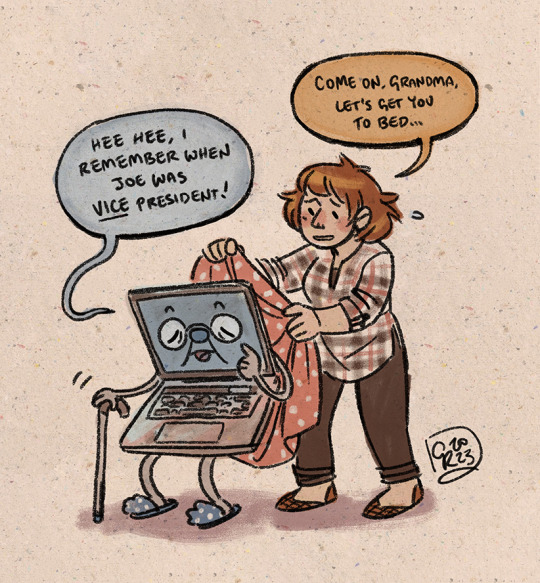
✨🥀💻I Need A New Computer!💻🥀✨
it's happened: my laptop is finally so old (she really does remember the Obama Administration!) that it can't handle any new OS updates, which is leading to inconvenient consequences. Like, discord crashes after attempting to download its latest update now, so I've been using the web version, in a browser that also yells at me regularly because it cannot be updated. Entropy is slowly swallowing it all, as entropy is slowly swallowing us all.
But before I, too, succumb to entropy, I do still need a computer for work, and also for my heavily computer-based existence, so I'm in the process of buying a desktop PC! After using macs at home since 2002, I'm excited to be making the switch to technology that will let me do incredible things like 1) play most video games and 2) stream sound over OBS without downloading third-party software and watching a youtube tutorial by a guy named SuperMacHaxxTurbo. But in order to welcome home my next computer, I need your help!
I have various stickers, art prints, and other items, fandom-based and original designs, for sale on my Redbubble store, if you'd like to manifest some of my art in the physical plane. Over on my patreon, you'll find years' worth of archived work, exclusive art, and step-by-step process breakdowns for $1/month-- and I've been posting a ton of art on patreon lately, so there's never been a better time to subscribe! I also have a ko-fi, if you just feel like sliding me some cash. All of these are linked in my pinned post!
If you've been enjoying my art for a while, or just since recently, I hope you'll consider also supporting me monetarily, if you're able to! No matter what, I'm grateful to everyone who follows me, and all of you rock.
Thank you!
653 notes
·
View notes
Link
There is a wide variety of Software Solutions for the Pharmaceuticals Industry Are Available through which any pharma industry can streamline its process effectively. Nanorobotics, 3D Printing, human simulators are few software solutions that are helping the pharma industry in a uniquely different way. To explore CDN’s IT Solutions For Pharma Companies and Biotech IT Solutions
#IT Solutions For Pharma Companies#Pharmaceuticals And Biotech IT Solutions#software solutions for the Pharmaceutical industry#3D printing technology#nano robotics for pharmaceutical industry#AR/VR devices for pharma industry#Human Simulator for pharma industry#Pharmaceutical industry#it solutions for life sciences#mobile app development#web app development#business it solutions#healthcare it solutions
1 note
·
View note
Photo

RJO Ventures, Inc. dba BrandingPower365.com. Founder: #richardjohn786 Mobile Solutions, Digital Marketing, Signage & Installs, Technology Services, Graphics & Printing, Technology Software, Technology Hardware. https://www.BrandingPower365.com https://www.RJOTechnology.com P.O. Box 640337 Miami, Florida 33164 Phone: 786-208-1529 Email: [email protected] (Graphics, Signage & Print) Email: richardjohn@rjoventuresinc. com (IT Consultant) #cloud #cloudcomputing #web #websitedesign #webdevelopment #digitalmarketing #signage #printing #graphicdesign #print #installation #technology #solutions #managedservices #apps #seo #ppc #affiliatemarketing #ads #marketing #partnership #RJOVenturesInc #BrandingPower365 #Miami #Florida (at Miami, Florida) https://www.instagram.com/p/CKjzcCjL2Jt/?igshid=1i9neh285rut0
#richardjohn786#cloud#cloudcomputing#web#websitedesign#webdevelopment#digitalmarketing#signage#printing#graphicdesign#print#installation#technology#solutions#managedservices#apps#seo#ppc#affiliatemarketing#ads#marketing#partnership#rjoventuresinc#brandingpower365#miami#florida
0 notes
Text
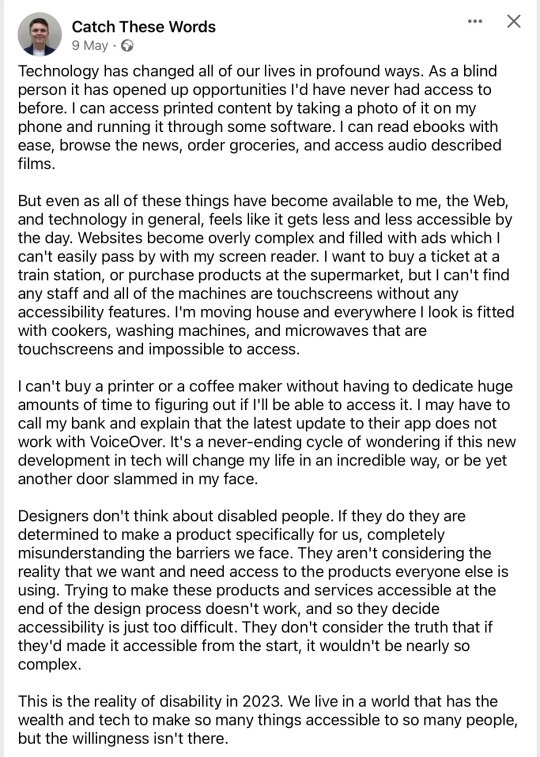
ID: a tweet by Catch These Words 9 May
“Technology has changed all of our lives in profound ways. As a blind person it has opened up opportunities I'd have never had access to before. I can access printed content by taking a photo of it on my phone and running it through some software. I can read ebooks with ease, browse the news, order groceries, and access audio described films.
But even as all of these things have become available to me, the Web, and technology in general, feels like it gets less and less accessible by the day. Websites become overly complex and filled with ads which I can't easily pass by with my screen reader. I want to buy a ticket at a train station, or purchase products at the supermarket, but I can't find any staff and all of the machines are touchscreens without any accessibility features. I'm moving house and everywhere I look is fitted with cookers, washing machines, and microwaves that are touchscreens and impossible to access. I can't buy a printer or a coffee maker without having to dedicate huge amounts of time to figuring out if I'll be able to access it. I may have to call my bank and explain that the latest update to their app does not work with VoiceOver.
It's a never-ending cycle of wondering if this new development in tech will change my life in an incredible way, or be yet another door slammed in my face. Designers don't think about disabled people. If they do they are determined to make a product specifically for us, completely misunderstanding the barriers we face. They aren't considering the reality that we want and need access to the products everyone else is using. Trying to make these products and services accessible at the end of the design process doesn't work, and so they decide accessibility is just too difficult. They don't consider the truth that if they'd made it accessible from the start, it wouldn't be nearly so complex.
This is the reality of disability in 2023. We live in a world that has the wealth and tech to make so many things accessible to so many people, but the willingness isn't there.”
Yup.
You need to build accessibility into everything - from products to events to government initiatives- from the start or you’ll decide it’s too costly and too complicated, without considering how any other aspect would be if you tried to build it in in the final stages.
The amount of money councils and corporations spend on “consultations” with disabled people that go nowhere because of this could easily be used to employ us and include accessibility from the beginning, working from lived experience.
26 notes
·
View notes
Photo

MacAddict February 1998
This issue’s focus on graphics included an article on how to design and print your own “zine.” Cheryl England’s editorial offered predictions for 1998, leading off with “Apple will introduce something really new, something really stunning, something that will get people’s attention. Yes, we’re serious about this”, but following that with “Apple will extend UMAX’s Mac OS license into 1999″, “Macs will finally come in different colors”, and “Streaming technology will actually work on your Macs so you’ll be able to watch video right from your favorite Web page.” Myth and Riven led off the reviews section, and both games received MacAddict’s most enthusiastic rating.
28 notes
·
View notes
Text
PRINTED GUNS - Where are we now?
PRINTED GUNS – Where are we now?

The bad guy in the book brandishes an untraceable 3D-printed ‘ghost’ gun. But how much of a threat are they really?
To build a 3D gun, you’d need the plans. I can imagine these are available somewhere on the dark web. (For reasons unclear to me, U.S.A President Trump has been trying to make such plans available online, but has been blocked by 20 states, who are suing over this issue.)
You’d also…
View On WordPress
#3D printing#African comics#comic#dark web#ghost guns#Graphic Novel#internet#movie project#technology
0 notes
Text
This day in history
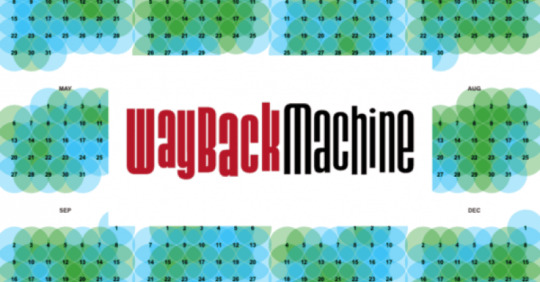
#20yrsago DRM is philosophically broken, too https://www.wired.com/2003/06/copy-protection-is-a-crime/
#20yrsago New PageRank optimization may pave way for idiosyncratic Google https://www.eurekalert.org/news-releases/704975
#15yrsago Security guards threaten NPR photogs with arrest for shooting panorama of DC’s Union Station https://web.archive.org/web/20080517104116/http://www.andycarvin.com/archives/2008/05/almost_arrested_for_taking_photos_at_uni.html
#15yrsago Warner/DC comics shuts down children’s cancer charity auction over trademark https://web.archive.org/web/20080517045311/https://sayitbackwards.blogspot.com/2008/05/important-charity-auction-update.html
#15yrsago Grateful Dead shake down NPR over including a song in an online mix https://www.npr.org/sections/monitormix/2008/05/days_be_more_than_all_we_have_2.html/
#15yrsago Analog switchoff == DRM screwjob https://tidbits.com/2008/05/12/digital-rights-misery-when-technology-is-designed-to-fail/
#15yrsago US and EU commissioner trying (again!) to sneak software patents into Europe https://web.archive.org/web/20080514074905/http://press.ffii.org/Press_releases/McCreevy_wants_to_legalise_Software_Patents_via_a_US-EU_patent_treaty
#15yrsago London supermarket secretly photographs alcohol/cigarette buyers, wants national database https://www.dailymail.co.uk/news/article-566181/Hi-tech-face-recognition-cameras-used-Budgens-spot-underage-drinkers.html
#10yrsago Inside the world of “booters” — cheesy DoS-for-hire sites https://krebsonsecurity.com/2013/05/ddos-services-advertise-openly-take-paypal/
#10yrsago “Citation needed”‘s Wikipedia entry https://en.wikipedia.org/wiki/Citation_needed
#10yrsago Scientology sucks at photoshop https://tonyortega.org/2013/05/12/scientology-sunday-funnies-portland-is-now-cleared-on-to-the-rest-of-earth/
#10yrsago How Anonymous got involved in fighting for justice for rape victims https://www.motherjones.com/politics/2013/05/anonymous-rape-steubenville-rehtaeh-parsons-oprollredroll-opjustice4rehtaeh/
#10yrsago 3D printed guns and the law: will judges be able to think clearly about digital files when guns are involved? https://www.theguardian.com/technology/2013/may/13/3d-printed-guns
#5yrsago White woman calls cops on black family who barbecued in Oakland Park’s barbecue area https://panthertimes.com/2018/05/02/white-privilege-used-to-fight-racially-charged-harassment-at-lake-merritt/
#5yrsago 75% of Theresa May’s £50m gift to grammar schools will go to Tory districts https://www.mirror.co.uk/news/politics/it-looks-like-shameless-bribe-12520491

Catch me on tour with Red Team Blues in Toronto, DC, Gaithersburg, Oxford, Hay, Manchester, Nottingham, London, and Berlin!

6 notes
·
View notes
Text
I think everyone has heard the term “supply chain crisis” at this point. Manufacturing centers were first hit in late 2019 and most to the global lockdowns were in effect by the second quarter of 2020. It is now third quarter of 2022 and we are into year three of this “interruption”, it is time to discard this outdated and frankly wrong from the start system of manufacturing and distribution. Americans in particular were already caught in a state of duality in which much of the public laments that nothing is made domestically, while also discarding anything made by local shops as “overpriced hipster gear”. I have previously stated that for true domestic production to return to America there would need to be enough demand for the products to cause more competition and drive the prices down as domestic supply increased.
That is the current situation as I see it, so now what do we do about it? In the last decade one particular technology has taken off, once a novelty and hyper expensive tool for industrial prototyping, 3D printers have become affordable, commonplace, and surprisingly capable. While still used by many to produce novelty items and in industrial roles, this technology is akin to the movable-type printing press of the mid-1400s in that it represents an upset to the established order if utilized effectively. Now before this is dismissed I am aware of the limitations of what can be printed at home. More exotic and expensive versions are used to produce high strength items. But this is where it gets interesting, because it isn’t about everyone having a printer. It’s about everyone using home printers to get a head start on skills, hobbies, and trades they couldn’t afford to break into otherwise and then using those skills to work with each other.
Lathes or milling machines are both often said to be machines that make machines. 3D printers should be included in that list. Now there is nothing made on this machine that can’t be done with other tools and methods, but few that allow the low cost of entry and ease within a home settings. Open source software and thousands of free files allow anyone and everyone to make tons of tools, dies, forms, jigs, stencils, etc. as needed. I've seen sheet steel stamped on dies made from common PLA on a cheap press from Harbor Freight, or even just stuck with hammers. My cousin makes brackets for electronics with an entry level printer while his wife makes custom cookie cutters for various events on the same machine.
And that’s the thing about this, the broad range of applications combined with people’s varied and personal interests. With the addition of a chop saw and drill for extruded or tubular metal you can make strong supports for printed pieces to form a much larger machine. If you can make a drill press or milling machine, you can make a lathe, manually operated or CNC. I’ve seen people make large format CNC router tables that can quickly and efficiently cut and trim an entire sheet of plywood for assembly. If within a community most people have the ability to make their own simple plastic or resin tools and utensils, while someone has a garage metal shop, another a carpentry shop, a couple down the road a leather shop and sewing studio, someone else a pottery studio, even a small foundry for smelting and casting, you would have a far more self-reliant community than anything seen in a hundred years in much of the western world.
I was originally going to link a bunch of videos showing the possibilities and I still might add some later on about specific applications. But I really want everyone to give this some serious thought on their own. Is there a hobby or trade you are interested in but you’re concerned about the investment? Look at what the essential components are. Can the more complex ones be found used? The cheaper ones made at home? We, as in all of us, are in a massive web of unsustainable distribution and centralized manufacturing. I don’t believe the key is to change where that center is, but to replace it with local and regional decentralized networks of skilled individuals whom own their own tools and shops.
#self reliance#sustainability#decentralisation#3d printer#trades#hobbies#skill set#new skills#casting#welding#machining#carpentry#pottery
40 notes
·
View notes
Text
Inform 7 Basics Continued (#4)
About rooms: making a room is a big deal! I don't mean this in terms of craft, or writing, or programming. Those are all big deals, it's true, but I mean that a room is all that Inform needs to compile a story. Seriously! Just type
Lab is a room.
in the IDE (development application available for Linux, Windows, and MacOS) and click the "go" button. You have a fully operational, releasable story (Inform programs are called "stories). Release it, and open it in an interpreter (a VM application for running Inform stories) or publish it to the web!
Now, it won't be an interesting game, mind you, but it shows how robust that built-in command support is with the typical Inform 7 IDE installation. Thanks to some pre-installed extensions (out in the programming world, these are comparable to code libraries), there are a ton of default actions that a player can perform in this lab. The largest and most important of these is the Standard Rules. This code (and code for other extensions) is not a black box; it can be viewed at any time.
Conveniently, compiling a game also builds something called the "Index", which is a graphical, hyperlinked reference containing all defined actions, an auto-generated map of the game world, and lots of other stuff. The index grows as your project grows. It is an Index of your story, including built-in code from extensions like the Standard Rules. That's not all. It has hyperlinks to the relevant code in your story. All you need is a room to get started.
Making a room is a big deal.

But what about making rooms? Programmers typically use the room name "Lab" for test situations. It's short, for one thing, and labs are good places for experimenting. So, again, this is the code:
Lab is a room.
Now, as nice as it is to have a working story with an index, people expect rooms to be described.
Lab is a room. The description of Lab is "The organization's magnetic propulsion lab focuses primarily on railgun technology."
There is more than one way to phrase this, but I like keeping things on separate lines for readability. I think that a key feature of Inform 7 is that it can be very readable. Even inexperienced programmers (like me) can follow a lot of Inform 7 code.
OK. We now have a room description and a story we can compile. What else? Well, "lab" is convenient for us to type, but players might appreciate something more interesting. We change this pretty easily:
The printed name of lab is "Magnetic Propulsion Laboratory".
What if we want more than one room?
Lab is north of the Annex.
This automatically creates a room called "Annex". We can type "SOUTH" or "S" and the command prompt and walk there from the lab. Unless we tell it differently, Inform 7 will automatically assume that we can walk from the Annex to the Lab by typing "NORTH" or "N". As promised, the beginnings of a map appear in the Index. Note the orange links, which jump to the places where the rooms are defined in code.

Since Inform 7 is optimized for designing parser games, beginners can immediately jump in and start creating and designing the story's geography.
Sample Code:
Lab is a room. The printed name of Lab is "Magnetic Propulsion Laboratory". The description of Lab is "The organization's magnetic propulsion lab focuses primarily on railgun technology.".
Lab is north of the Annex. The printed name of the Annex is "Magnetic Development Storage". The description of the Annex is "This is a general storage area for equipment related to railgun technology development.".
Output:
Welcome An Interactive Fiction Release 1 / Serial number 230607 / Inform 7 v10.1.2 / D
Magnetic Propulsion Laboratory The organization's magnetic propulsion lab focuses primarily on railgun technology.
>s
Magnetic Development Storage This is a general storage area for equipment related to railgun technology development.
>n
Magnetic Propulsion Laboratory The organization's magnetic propulsion lab focuses primarily on railgun technology.
Next time: things.
4 notes
·
View notes
Text
The small things Manifesto
This is a work in progress, a living document.
Small is good, small is all (The large is a reflection of the small)
small technology, small economy, small community
Many of the major technological and cultural innovations of the last several hundred years have served to flatten the world, eliminate or obviate distance, and bring us closer together as people. Printing, transportation, telephone, radio, television, home video, and the internet have each, in their own way, made our impact on the world bigger, and made parts of the world smaller.
But this came at a price.
Technology is not a net good, or even a neutral force. Technology is a Force Multiplier. It reshapes the world to fit the vision of those who design it, regulate it, and wield it. Oil companies poison our lakes and rivers, slowly boiling our planet. Facebook tracks everything we do online and uses that data to make us miserable. Disney owns an outsized portion of modern folklore. The FCC decides who gets to launch a radio station, and under what circumstances. Television turns reasonable people in to rabid fans of raving monsters, and turns raving monsters in to celebrities, politicians and thought leaders.
It does not have to be this way.
It is this way thanks to a combination of factors, most of which can be summarized as “The Profit Motive.” For some companies, making people angry is a surefire way to drive Engagement, and driving Engagement is a surefire way to make money. For other companies, the money lies in controlling our access to our own culture, gatekeeping who is allowed to tell stories, and when, and how. For these major corporations, there is no incentive to Help, to Improve. There’s no money in making the world a better place.
It will not be easy.
Most new technologies, but especially Digital technologies, experience a period between inception and corporatization during which they flourish as a result of a bunch of disparate people with distinct goals who Explore the space that the technology creates, often without regard for profit of any kind, or at least with some motivation beyond pure profit. Then there is, usually, a period of contraction and consolidation around the things that have made the most money (or, in the case of television, have had the most Regulatory support from the corrupt FCC) and you’re left with HBO/DISCOVERY, Disney, Facebook, and Joe Rogan.
But we can reject the profit motive!
Local theater still happens, in spite of the fact that it stopped being profitable ~100 years ago. Local music still happens, in spite of the fact that only 1 band in 100 is going to make their living making music, and significantly fewer than that are ever going to Make It. Small creators make video games in their spare time because they enjoy it. Hundreds of people work together to run free and open alternatives to major social media networks, funded out of their own pockets.
Ars Enim Mutare; Art for change
These things happen in isolation, from creators who make things because the want to make things. They toil, often in isolation, for little reward. This is a call to action for solidarity, and support and intentional creation. We can reshape the world, and support one another as we do it. We can opt out of activities that enrich corporations that seek to make us suffer or to destroy us. We can (and must) become our own media.
What are small things?
Small things are art, media, technology, and culture created by People who are treated fairly, for people who are treated fairly, shared freely and sustainably. There are no corporate overlords, no gatekeepers, no Web Scale Technologies, and no ways to get rich.
Why are small things?
Because, in a world where Creation and Communication are heavily commercialized, the act of Creating a Thing or building a community that doesn’t enrich our corporate overlords is a radical act.
Because big complicated communities and systems are hard to manage without the resources of a government or corporation. If we keep things at the Human Scale, rather than the Global Scale, we stand a chance of being successful at the Human Scale (that is to say, surviving and sustaining, building relationships, etc.)
Because 4 corporations control 90% of our news and entertainment media, three corporations control the vast majority of online communication, and no corporations give a single damn if we live or die. Too much power is consolidated in the hands of too few.
They buy off our politicians, influence who gets elected, write some of our laws, and ignore the ones that are inconvenient. They’ve rigged the game such that they’re the only ones big enough to play.
We, as individuals and small communities, need to work together.
We must carve a new path.
a Small Society
This is a political document, describing the intentions, motivations, and views of a small group of people practicing community scale creation. Following these artistic, social, and technological principles might help lead to more fair and just societies.
We live in an era of unparalleled abundance, unevenly distributed. The Abundance created from our labor, from our creation, from our communities, is stolen from us, bundled up and smashed against the abundance of our neighbors, and sold back to us.
They leave us with artificial scarcity, while they feast on the abundance of our labor. This Large abundance enriches a powerful few at the expense of a disenfranchised many. The few and powerful have convinced themselves, or pretend among themselves, that the abundance they steal from us is something that they create, and that it can Grow Forever.
This is, of course, nonsense. Nothing can grow forever. Indiscriminate growth is harmful and destructive, and the consolidation of wealth and power in to the hands of so few is both destructive and useless. Capitalism, in it’s current form, is a cancer that will consume and destroy everything
This large abundance goes to waste, and those who create it are forced to make do on the scraps that remain. Every dollar in the pocket of a billionaire, not being spent, gathering dust, collecting interest, is a dollars worth of food that is not on a worker’s table.
We do not have to accept this. In fact, we cannot accept this. We must reject the illusion of infinite growth, support one another, and embrace our small abundance.
Small Community
We are building a movement, but we are building a movement Made of People. Small groups of people form communities. Groups of communities form networks. Networks of small communities can accomplish more and make decisions faster than one large group.
We can and should care about our neighbors, our community members. We look out for one another. We tell our stories. We protect our community, and make sure everyone is fed and housed to the best of our abilities.
Small Technology
Big technology is extractive, oppressive, and a tool for indoctrination and radicalization. Small technology is technology for People. Human scale technology. Understandable, implementable, respectful. It does not spy on you, it does not steal from you, it does not seek to manipulate you.
Small Technology is a Big Topic that deserves more words than I’ll give it here.
Social media
Write a blog, start a newsletter, maybe use the fediverse. Whatever you end up doing, avoid Facebook and google wherever you can.
Communication
Send an email, run an element server, don’t let Gmail and Facebook control your communication.
Storage
Syncthing and nextcloud work as well as dropbox, and don’t spy on you.
Distribution
Host your own website. Use wordpress or neocities or some other platform. If you don’t want to pay to rent a server, run something like yunohost on a raspberry pi in a closet in your home. It won’t be available 100% of the time, and it won’t be fast, but it’ll be Good Enough and you’ll learn a lot along the way.
Creation
Free tools for creation exist and are great. Look at Krita, glimpse, kdenlive, and dozens of others. All of the work I do is powered by free software.
Small Media
Make things because you like to make them. Share things because you want to share them. People have done this since the dawn of time. Members of the Arts and Crafts group the Roycrofter were self publishing zines in the 1890s using letterpress, Lainsville TV and The Videofreex were producing independent television with the first consumer video cameras.
You don’t need budget, you don’t need technology, you just need something to say.
Small things:
This is a list of things that are small. Not every thing on this list will conform to every principle of the small things manifesto, but they all have a similar flavor.
Zines and comix
By their very nature, Zines (self published, DIY magazines) are Small. They’re usually hand made. They’re usually distributed freely or cheaply. Go embrace Zines and Comix from your local book or record store.
The slow/small/indie web
The internet does not have to belong to Amazon and Google and Facebook. Projects like Gemini imagine a new kind of web. Projects like the fediverse (see Mastodon or Hometown) create an alternative to Twitter and Facebook. Tilde servers, and places like SDF provide a place for communities of tech enthusiasts to get together outside the control of a massive corporation.
Email is, outside of gmail and yahoo mail, still Federated and peer to peer.
Services like Peertube (which powers New Ellijay TV) allow sharing even videos from underpowered simple computers on home internet connections, and projects like yunohost simplify the maintenance and deployment for self hosting on simple cheap computers.
Podcasts
Most podcasts are Small Media, even if they don’t consider themselves to be. They’re independently produced media distributed using small technology (RSS). Corporations like Spotify and Apple and Google have attempted to gatekeep podcasts, but anyone can go to most podcast’s website and download and subscribe with any podcatcher.
Many podcasts lean in to this, distributing under an entirely open license.
Most podcasts start real rough around the edges, not only is that Fine, it’s also Good. Embrace imperfections. Reject perfection.
Music
Lots of small music gets made every day. Most DIY/Punk is small music, but to my mind there has never been a more perfect example of the Ethos of Small Production than All Hail West Texas by The Mountain Goats. Recorded on the internal mic of a boombox, it’s a Deeply emotional and absolutely perfect record that lives in, relishes in, its flaws. “Hail Satan, tonight.”
It’s not CC licensed, but it predates the entire concept, so I can’t fault it.
Principles of Small Creation
Scale and complexity are traps;
It doesn’t have to be scalable to 10M concurrent users if it’s only going to be used by 10 people.
It’s better to work okay every time than to work perfectly one time in ten
There is freedom in a lack of professionalism, in doing things incorrectly, and in doing things poorly
A lack of commercial prospects is not a reason to prevent yourself from Coding or Singing or Drawing or Writing for the joy of the doing.
We build things for people
Specific people, small numbers of people, knowable, manageable groups.
Include people
We strive for the things we make to be Understandable when they need to be understood; Usable (and useful), when they need to be used; Enjoyable, when they are meant to be enjoyed; Discoverable, so that they can be found.
Level editors! User Generated Content! Customization! Permision to remix and reuse and cover and sample and to do all the things.
Respect our audience (users, viewers, consumers, etc.) and our artists (coders, videographers, musicians, etc.)
Credit your collaborators
Protect the vulnerable in our communities.
Compensate people as fairly as is possible.
Don’t track users or harvest data
No “Proof of work”, if you hear the word “blockchain”, slap someone.
Do offer options for customization when possible
Try to build things that will last.
Consider the impact on your community when you no longer exist to provide the thing. How will The Thing outlive you, if it can outlive you?
Consider the impact of your work on your community, strive to do no harm.
Share, and make sure everyone else does
This means licensing clearly, and making attribution easy
We use CC-BY-SA for media and (a)GPL for software.
More permisive licenses are fine, more restrictive licenses aren’t.
“CC-ND” limits the ability for others to transform your work, perpetuating the worst parts of our current copyright system.
“CC-NC” prohibits those who share your work from monetizing in any way. Including CC-NC content in a magazine or web page with advertisements is a license violation, this can quickly lead to unsustainable situations.
The licensing thing scares a lot of people off. CC-BY-SA means Share it with other people, credit me for it, and if you decide to make any changes or incorporate this in to another work, release your stuff under the same terms.
This lets us distribute Small Media through lots of disconnected networks, while making sure that anyone who wants to can find the creator (and pay them!), and ensuring that a company like Disney won’t swoop in and profit off of our hard work.
Know your neighbors
Physical or digital, get to know your community. Makes it easier to look out for one another.
We’re all real people, after all.
Make it quick, make it cheap, stop when you hit Good Enough
No one is going to be upset that your low budget, anti-capitalist disaster movie doesn’t have billion dollar special effects. Tell the story and move on.
Quick doesn’t mean “Go as Quickly as you can”, it means “cut out any steps that won’t help you finish the thing.” Don’t burn yourself out making a small thing! But also, don’t spend so much time polishing the thing that you never finish it.
Don’t give power and money to those that seek to destroy you, when an alternative is available
Disney, Comcast, Fox, Sony.
Provide community based alternatives to the things that major corporations create
We can make our own News, entertainment, social media, music, art, games, toys, clothes, and food at various capacities.
Support one another
If you can afford to pay a creator who made a thing you enjoy, do.
If you enjoy a thing, tell soemone about it.
If someone needs help that you can provide, consider helping
If you need help that someone else can provide, ask
Forget the social norms that prevent you from asking for help, or that lead you to disparage those who do
If you’ve got nice gear, share it
We help us.
Don’t let Gear stop you
Use what you have.
Nearly any cell phone can produce Good Enough video. Steven Soderbergh shot Unsane and High Flying Bird on iphones.
“All Hail West Texas” was recorded on the integrated microphone on a cheap, barely functional boombox, and it sounds like it. It sounds bad! It’s still a wonderful, award wining album.
Dozens of award winning documentaries were shot on the first consumer video cameras. These cameras produced some of the worst video footage imaginable. It’s fine, anyone who cares more about the Fidelity of your gear than about the quality of your work is missing the point.
Most of our gear is second hand and a lot of it is 10+ years old. Keep it out of landfils.
If you want to and can buy some gear, find something good enough, and stop thinking about it
There’s nothing wrong with using something nice, if you have it or have access to it, but Diminishing Returns are real.
It’s better to have a finished thing that’s lo-fi than an unfinished thing in perfect fidelity
Every dollar spent on gear, is not spent on the people involved, the sets, the costumes, etc.
Not everything has to be a Small Thing, but the best big things start small.
Sustain
Don’t burn yourself out
Take care of yourself and, if you can, help your neighbors
Other Small Things
People are always making small games, small software, small art. This is good! We’re going to compile as many small things as we can in to a regular feature in the analog revolution zine, and on our website.
Small Things are the next big thing.
Make something.
Find something someone else made, and tell your friends about it.
Lift one another up. Reclaim the future. Ignore the Megacorporations. Start something worth doing.
12 notes
·
View notes
Note
Hey there Miyabi! How do you get such high-res, beautiful, and professional scan quality? What's your process?
Thank you! I certainly don't think I do anything that professional, so glad you have been decieved into thinking that about them! LOL I started doing this scan of the day stuff just to bring better quality to a lot of the older contributions of mine floating around the web. Looking at them on here, the Megaman wikia and other places, they just felt small and dirty. Especially as basic technology had gotten better over the decade or so since I first scanned them. I have 2 different scanners, one of which is a fancier Epson that I bought specifically to scan film slides a year or so ago. Still use it for basic scans from time to time. But honestly, for the settei, I'm still just using my general home HP Envy printer/scanner combo. I always scan at 600 DPI. After that part is done and the bitmap image is scanned to my computer, it's really just doing some heavy touchup. As I have alluded to in some recent posts, some of these sheets will take me an hour to an hour and a half just to clean up, because they have so many artifacts and dotty garbage on them. Settei at auction are mostly just scanned copies themselves after all, so there's a bit of residue to clean up. Ever wonder why sometimes I don't post these at a regular time of day? That's why, I'm still working on touchup before I post (and probably off from work, so I'm not prepping the night before, like when I post at a scheduled time).
Let's use this recent Gauss sheet as an example.
The original scan was pretty messy. Probably can't see it as well in tumblr resize scale, so here's the original scan. But it is dotted all over the place, there's like a smudge line which goes through the whole bottom of the sheet, where the "Final Draft" stamp, character/episode number marking is, and through some of Gauss' headshots as well. You can also probably see some black on the edges, where the sheet comes to an end within my scanner.
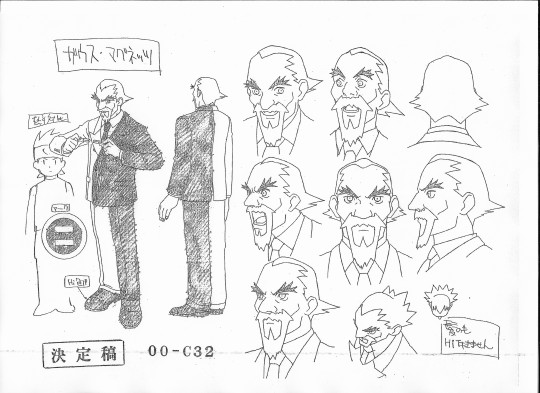
The first bit of touchup I usually do is within my image viewer. I use FastStone Image Viewer to help organize and view everything. In there, I will adjust the brightness, contrast, and sometimes the gamma, to get the sheet background a bit lighter and the lines darker.
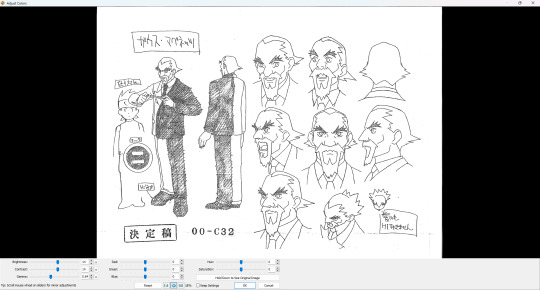
I just like the number 14. Is it always 14? No. But that's usually my baseline starting point. After that's saved, into the photo editing program of choice we go. I match my brush color to the background white and just paint over all those ugly dots and wipe those black edges away.
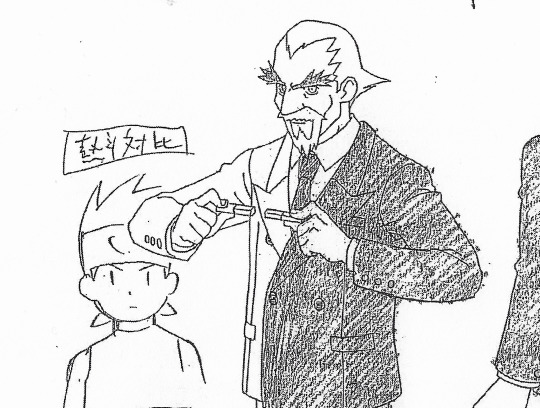
Zoom in at 100% to try not to miss those artifacts you don't notice zoomed out. Look at Gauss' speckled fingers. Ugh, cleaning that stuff up is hell. But I do it, so you all can see clean-ish looking art. Do I get everything? No. But I try to at least get the major issues out of the way.
Some things I take liberties on. The shading on his jacket goes outside the lineart. Should I leave it as is for authenticity? Probably. But if I'm cleaning it, I'm gonna clean it all. So you'll see in the finished version I posted, those shading lines are all inside the lineart only.
Some people are jerks and could easily resell these settei just by printing scans and claiming them as original. Another way I try to have a way to differentiate my edits without slapping a watermark on is my editing of the text boxes. See the top left and bottom right of it above Netto? There's almost always some overhang on the originals. I have usually taken the liberty of editing that overlap line off, so that the text box is a clean rectangle where the line stops at each corner, as close as I can take it. It's a dumb, but simple way for me to tell if it's my edit.
Otherwise, that's really it. Just a lot of added effort in touchup, honestly.
Cel scans are a little different, because most of them are too big for either scanner. Especially cels with backgrounds. So many of those involve 2-4 scans and then stitching them all together. Much less touchup that I do to them, but otherwise it's mostly the same. 600 DPI, and some brightness/contrast or slight color saturation adjustments to them, if needed.
And now you know!

9 notes
·
View notes
Photo







THIRD INSIGHT
QUANTIFYING CURIOSITY
Third Insight develops patented artificial intelligence (AI) that emulates the human reasoning process, integrating sensor fusion and knowledge-based problem solving to address the needs of both commercial and government customers. Our current projects include AI-based planning and navigation for unmanned aerial and ground vehicles (UAVs, UGVs) in cluttered and/or GPS-denied environments and neuro-symbolic techniques that integrate deep learning with human-readable knowledge bases.
Our customers include commercial partners, as well as the Departments of Defense (DOD) and Homeland Security (DHS). Applications of our platform for these customers include aircraft inspection, search and rescue efforts, and warfighter initiatives. We also support the USAF through the development of UAV-based environmental assessments. These techniques utilize deep learning and massive volumes of sensor data (optical, hyperspectral, LIDAR) to create tree species-specific maps of environmental health, which in turn facilitate DOD forest management.
Third Insight has over 100 years of cumulative experience spread out across our 8-person team composed of deep learning specialists, software engineers, and hardware experts.
LEARN MORE > https://www.thirdinsight.ai/
#digital#print#web#branding#rebrand#modern#minimalist#technology#ai#artificialintelligence#neuralnetworks#autonomoussystems#drones#iconography#abstract#gradient#work#geometric#colour#logopackage#logo#texas#usa#brand#brandidentity#logodesign#business#corporateidentity#homelandsecurity#departmentofdefense
0 notes